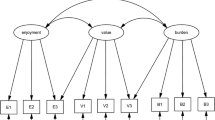Abstract
Summated ratings attitude scales commonly consist of numerous items whose scores are summed to yield a total score. An assumption underlying this technique is that the items in the scale reflect a common construct. If this is not met, the procedure produces uninterpretable data. Although this psychometric principle has been known for a long time, numerous studies in the literature demonstrate a neglect of it. Some make no attempt to conceptualise the construct to be measured; others conceptualise the construct but then ignore the possibility that it may be multidimensional; still others contain evidence indicating that the construct is multidimensional and then proceed to ignore that evidence. A possible contributor to the confusion is the misunderstanding of the related yet distinct concepts of internal consistency and unidimensionality. This paper presents examples of poor and good instrument design, in the hope that clarification of the issues might make a difference in the future.
Similar content being viewed by others
References
Billeh, V. Y., & Zakhariades, G. A. (1975). The development and application of a scale for measuring scientific attitudes.Science Education, 59(2), 155–165.
Brink, P. J., & Wood, M. J. (1988).Basic steps in planning nursing research (3rd ed.). Boston, MA: Jones & Bartlett.
Coulson, R. (1992). Development of an instrument for measuring attitudes of early childhood educators towards science.Research in Science Education, 22, 101–105.
Cronbach, L. J. (1951). Coefficient alpha and the internal structure of tests.Psychometrika, 16, 297–334.
DeVellis, R. F. (1991).Scale development. Newbury Park, CA: Sage Publications.
Gardner, P. L. (1975). Attitude measurement: A critique of some recent research.Educational Research, 17(2), 101–109.
Gardner, P. L. (1987). Comments on “Toward the development of a children's science curiosity scale”.Journal of Research in Science Teaching, 24, 175–176.
Graham, J. R., & Lilly, R. S. (1984).Psychological testing. Englewood Cliffs, NJ: Prentice-Hall.
Green, S. B., Lissitz, R. W., & Mulaik, S. A. (1977). Limitations of coefficient alpha as an index of test unidimensionality.Educational and Psychological Measurement, 37, 827–838.
Harty, H., & Beall, D. (1984). Toward the development of a children's science curiosity measure.Journal of Research in Science Teaching, 21, 425–436.
Harvey, T. J., & Vaughan, J. (1990). Student nurse attitudes towards different teaching/learning methods.Nurse Education Today, 10, 181–185.
LoBiondo-Wood, G., & Haber, J. (1990).Nursing research: Methods, critical appraisal and utilization (2nd ed.) St. Louis, MO: C. V. Mosby.
Piper, M. K., & Moore, K. D. (1977). The effect of a physics course for elementary teachers on attitudes toward science of preservice elementary teachers.Attitudes towards science: Investigations (pp. 20–28). Ohio: SMEAC, Ohio State University.
Polit, D. F., & Hungler, B. P. (1995).Nursing research: Principles and methods (5th ed.) Philadelphia, PA: Lippincott.
Woods, N. F. (1988). Assessing nursing research measures: Reliability and validity. In N. F. Woods & M. Catanzaro,Nursing research: Theory and practice. St Louis, MO: C. V. Mosby.
Author information
Authors and Affiliations
Corresponding author
Rights and permissions
About this article
Cite this article
Gardner, P.L. Measuring attitudes to science: Unidimensionality and internal consistency revisited. Research in Science Education 25, 283–289 (1995). https://doi.org/10.1007/BF02357402
Issue Date:
DOI: https://doi.org/10.1007/BF02357402




